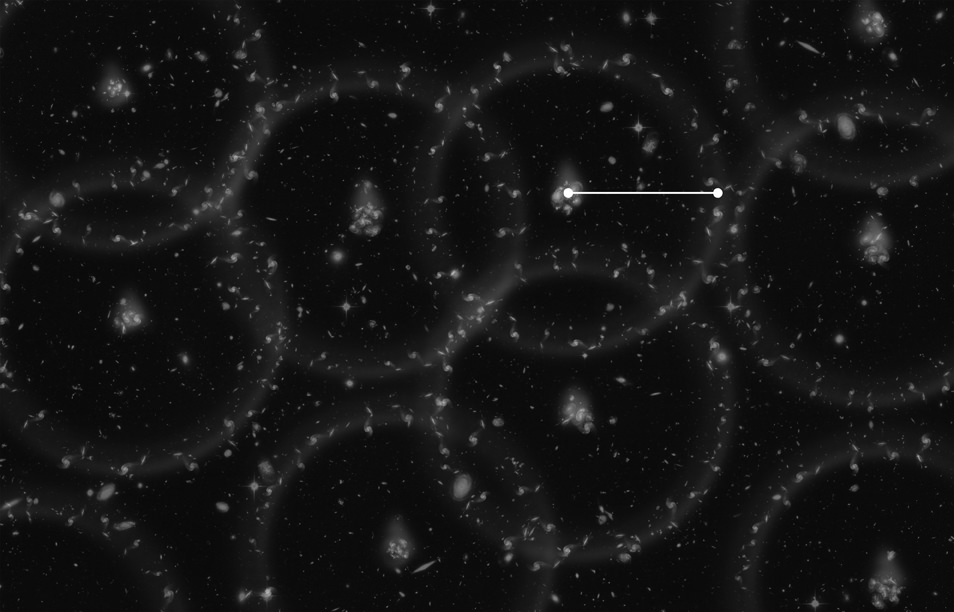Measuring cosmic distances is a major challenge thanks to the fact that we live in a relativistic Universe. When astronomers observe distant objects, they are not just looking through space but also back in time. In addition, the cosmos has been expanding ever since it was born in the Big Bang, and that expansion is accelerating. Astronomers typically rely on one of two methods to measure cosmic distances (known as the Cosmic Distance Ladder). On the one hand, astronomers rely on redshift measurements of the Cosmic Microwave Background (CMB) to determine cosmological distances.
Conversely, they will rely on local observations using parallax measurements, variable stars, and supernovae. Unfortunately, there is a discrepancy between redshift measurements of the CMB and local measurements, leading to what is known as the Hubble Tension. To address this, a team of astronomers from several Chinese universities and the University of Cordoba conducted a two-year statistical analysis of one million galaxies. From this, they’ve developed a new technique that relies on Baryon Acoustic Oscillations (BAO) to determine distances with a greater degree of precision.
The team included Kun Xu, a postgraduate researcher at Shanghai Jiao Tong University (SJTU) and the Institute for Computational Cosmology (ICC) at the University of Durham; Yipeng Jing, a professor at the Tsung-Dao Lee Institute and Shanghai Key Laboratory for Particle Physics and Cosmology at SJTU; and Gong-Bo Zhao, the Deputy Director of the National Astronomy Observatories (NAO-CAS), the University of Chinese Academy of Sciences (UCAS), and the Institute for Frontiers in Astronomy and Astrophysics (IFAA). They were joined by Antonio J. Cuesta, an associate professor of physics at the University of Cordoba. The paper that describes their findings recently appeared in the journal Nature Astronomy.
Baryon Acoustic Oscillations, first demonstrated in 2005, are one of the few traces of the Big Bang that can still be detected in the cosmos (like the CMB). During the first 380,000 years after the Big Bang, these waves propagated through matter so hot it behaved like a liquid, like ripples through a pond. As the Universe expanded and cooled over the next 500 million years, these waves effectively became “frozen in time.” Since the exact duration of these waves is known, they are very useful for measuring cosmological distances based on the separation between galaxies.
Detecting BAOs and determining their size is essential to accurately mapping the Universe out to objects billions of light-years away (cosmological distances). For their study, the team used statistical methods to examine close to one million galaxies contained in the twelfth data release (DR12) from the Baryon Oscillation Spectroscopic Survey (BOSS) CMASS samples, combined with the Dark Energy Spectroscopic Instrument (DESI) Legacy Imaging Surveys. This allowed them to obtain accurate information on the ellipticity of the galaxies and the density around them.
This was important since the gravitational force of neighboring galaxies typically stretches out galaxies to the point where they are in relative proximity to each other. But in some places throughout the Universe, this effect is not as intense. Upon examining all the combined data, they found that their method showed where BAOs could be found. As Prof. Cuesta stated in a University of Cordoba press release:
“It is in those points, where galaxies do not point where they should, where statistics tell us that the Baryon Acoustic Oscillations are located, since these waves also act as points of gravity attraction. The first practical application that this study could have is to establish more precisely where the galaxies are located, and the separation between them and the Earth, but, in a way, we are also gazing into the past.”

Combined with other methods in the Cosmic Ladder, this independent technique could help resolve one of the more troubling issues in modern cosmology. Obtaining accurate estimates of cosmic distances will open new doors in astronomy, including how the Universe has expanded over time. This could lead to revolutionary insight into the physics that govern the cosmos, potentially resolving questions about the existence and role of Dark Matter and Dark Energy – two of the greatest mysteries in modern astronomy.
They could also reveal that our notions of how gravity behaves on the largest of scales (as described by General Relativity) require some revision, perhaps leading to the adoption of alternative models like Modified Newtonian Dynamics (MOND).
Further Reading: EurekAlert, Nature


I liked this up to the point of mentioning MOND, since it is not generally seen as a viable alternative. [“Troubled Times for Alternatives to Einstein’s Theory of Gravity”, Eric Nyquist for Quanta Magazine, 2018.]
The paper has results that are mildly consistent with the final Planck 2018 LCDM values: “All these results are consistent with Planck18 within the 2? level.”